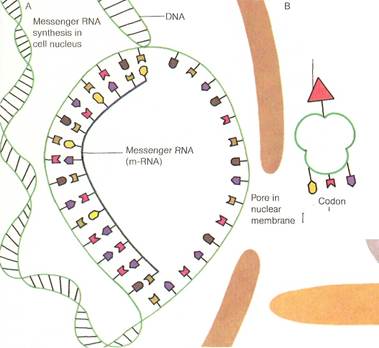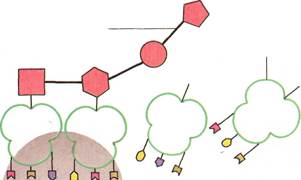
CATEGORIES:
BiologyChemistryConstructionCultureEcologyEconomyElectronicsFinanceGeographyHistoryInformaticsLawMathematicsMechanicsMedicineOtherPedagogyPhilosophyPhysicsPolicyPsychologySociologySportTourism
Structures of nucleic acids
Both RNA and DNA are made up of recurring units called nucleotides. These consist of complexes of three different molecules: a five-carbon monosaccharide (sugar), an organic base, and phosphoric acid. In RNA, the sugar is ri-bose. In DNA, it is deoxyribose, a ribose derivative.
The organic bases of DNA include two compounds and two molecules. The two py-rimidine compounds are cytosine (C) and thymine (T). The two purine molecules are adenine (A) and guanine (G). In RNA, uracil (U) is substituted for thymine. The sugar molecule is attached to both the phosphoric acid and the base. The phosphoric acid is linked to the sugar of the next nucleotide. Hence, any sugar molecule in the middle of the chain is linked to one base and two phosphoric acid residues.
Although the basic parts of nucleic acids had been known for many years, it was not until 1953 that Francis Crick and James Watson of Cambridge University worked out the three-dimensional structure of the DNA molecule. They suggested that the bases of two nucleotide chains are connected together by hydrogen bonds. The sugar and the phosphate run alternately along each side. This structure is similar to that of a ladder. The bases connected by the hydrogen bonds form the rungs. The sugars and phosphates form the sides of the ladder. The ladder is twisted into a regular helical formation, the famous DNA double helix. A helix has a spiral, coiled form, like a spring. The purine and pyrimidine bases are always found in complementary pairs. Adenine links with thymine. Guanine is in combination with cytosine.
The DNA double helix stores all the information about the structural proteins and enzymes that make up the organism. A few viruses contain only RNA and do not possess DNA. But in all other species, the purpose of the RNA is to transcribe the information stored in the DNA. The information is then transferred to sites in the cell, called ribosomes, where it is translated into the making of protein.
The genetic code
The sequence of organic bases in a DNA molecule forms what amounts to a four-letter code. This code must provide the words in an enormous encyclopedia of possible protein types. There are at least 20 words or amino acids in proteins. A single base obviously does not give sufficient information to specify what is needed to make the protein. Three bases together give a choice of 64 (4X4X4) combina-
 Biochemistry: Nucleic acids 115
Biochemistry: Nucleic acids 115


|

|

|
| Protein synthesisbegins in the cell nucleus (A) with the splitting apart of a section of DNA. A messenger RNA (m-RNA) molecule is then synthesized. The m-RNA is formed by the bases of free nucleotides pairing with complementary bases of the DNA. The bases that occur in RNA are adenine, guanine, cytosine, and uracil. This last base substitutes for the thymine that is found in DNA. The m-RNA then moves through a pore in the nuclear membrane and becomes attached to a ribosome (B). The ribosome is attached to the endoplasmic reticulum inside the cell. Next, transfer RNA (t-RNA) molecules transport amino acids to the ribosome. In addition to an amino acid at one end, each t-RNA has a sequence of three bases at the other. These bases attach to the complementary three-base sequence (called a codon) on the m-RNA. As the m-RNA moves along the ribosome, the amino acid on the t-RNA links to an adjacent amino acid. This builds up the polypeptide chain. This process is repeated until the protein molecule coded for by the m-RNA is complete. |
| Transfer RNA (t-RNA) |
| y"^1 ^QiyyfoQrfyp^y1? |
tions. Of these combinations of the four bases—A, C, G, and T— a total of 61 code for specific amino acids. Several different combinations therefore code for the same amino acid. The remaining three compounds perform the same function as the period at the end of a sentence. They show that the last amino acid in the protein has been reached. This theory that three bases code for a particular amino acid is supported by experimental evidence. The three-base unit is referred to as acodon.
DNA is found mainly in the nucleus of plant and animal cells. Proteins are manufactured in the cell, but outside the nucleus. They are manufactured by ribosomes within the cytoplasm, fluid that fills the inside of a cell. A complex chain of events links the DNA with the actual manufacture of protein.
Protein synthesis
The double helix of DNA is the largest molecule in the cell. RNA exists as much smaller molecules and in several different types. To relay information to the ribosome (which manufactures the protein), the two strands of the DNA double helix must first split apart, like a zipper, along the appropriate part of the molecule. A molecule of messenger RNA (m-RNA) is then formed from free nucleotides. The nucleotides pair with the bases of the section of DNA coded for the required protein. The RNA bases pair only with the complementary bases of the DNA. Thus, the information is coded "in negative." The sequence of the RNA must be transcribed back into its original form. This is done after the m-RNA has moved out of the cell and taken up a position on the ribosome. Another RNA molecule called transfer RNA (t-RNA) picks up a free amino acid and takes it to the ribosome. The enzymes that control this attachment are highly specific. Each molecule of t-RNA carries only one type of amino acid. The t-RNA molecule is smaller than m-RNA.
It consists of a single nucleotide chain twisted back on itself into a cloverleaf shape. At one end is a sequence of three bases that attach to the appropriate complementary codon (three-base unit) on the m-RNA. The amino acid at the other end is enzymatically joined to the polypeptide chain as the m-RNA slides along the ribosome. Several protein molecules may be formed simultaneously from the same m-RNA molecule.
The same genetic material is found in all the cells of an organism. But not all the cells produce the same proteins. There are also differences in the rates of production between cells. The mechanism by which the function of a gene (the section of DNA that codes for a particular protein) is controlled is not completely understood. Production of a protein can be stopped or slowed down in three ways. The DNA can stop making m-RNA. Attachment on the ribosome can be prevented. Or the rate at which m-RNA is destroyed can be increased.
Mutations
DNA is a huge, extremely complicated molecule. It is inevitable that mistakes in its duplication occasionally occur. These are called mutations. They happen when the wrong base is coded or when sections of DNA are removed or put in the wrong place. Ionizing radiation (like atomic fallout) and some chemicals increase the rate at which these mistakes occur. They probably inhibit the natural repair mechanisms. Some mutations produce inheritable diseases. This usually happens where the change causes the production of the wrong amino acid. This renders an enzyme ineffective by altering its shape.
| Protein synthesis in cytoplasm of cell |
| Amino acid |
| Polypeptide chain under construction |
| Ribosome |
| Endoplasmic reticulum |
Mutations are now also known to cause cancer, which is an abnormal growth of particular cells. But not all mutations are damaging. Some cause beneficial variation in a species, which is an important mechanism in evolution.

|

| Complete structu | e of | / | |
| adenosine triphos | phate (ATP) | ||
| II | II | II | |
| HO —P- | -o—p- | -o- | -p—o- |
| 0* | f 0 | 1. . o | |
| \ |
NH
OH
OH

|

|
+
Water
OH
+
| HO- | II -P- 10 | -OH |
Phosphate ion
+
Energy
Date: 2015-12-11; view: 3322
| <== previous page | | | next page ==> |
| Many species of fungi, | | | During strenuous activity |